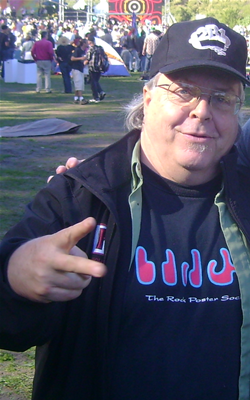
Boots Hughston at West Fest 10/25/09 |
Boots Hughston began playing the saxophone in the 1960s/1970s with many legendary bands including Santana, It’s a Beautiful Day, Marty Balin (Jefferson Starship), Nick Graventies Blues Band, John Cipollina (Quick Silver), Van Morrison, Bobby Blue Band, The Hoo Doo Rhythm Devils, Gregg Allman, and his own bands called Aum and Womb. Boots promoted his first show with Lue Williams and the “Stray Cat” at California Hall in San Francisco. The concert included Janis Joplin and Big Brother. Hughston was drawn to the idea of simply putting up posters and being able to hang around music events. Boots and his brother Lance started the annual “North Beach Photographic Art Fair” which was a free outdoor event drawing 30,000 people over three days, 21 bands, and hundreds of crafts and photographers. The fair grew into what would become the “North Beach Fair” which became the premier outdoor event in San Francisco’s North Beach. He has also served on the founding “Cinco De Mayo” festival committee as its production coordinator. In the mid 70s, Hughston worked with the legendary “Family Dog” and Chet Helms as production manager for the “Tribal Stomps” in Berkley and Monterey. |
|
His next big step in promotion came when he met fellow promoter Doug Green who had a dream of making a venue in the mountains of California. With chainsaws, bulldozers, and no money, they carved out of the mountain the venue known as “Reggae on the River”, Frenchs Camp. Hughston is credited with single handedly awakening the legendary “Family Dog” as a production company that helped to start the 60s movement. Hughston is currently committed to bringing creativity back to music and fight the strangle hold BPG (SFX and Clear Channel) has on the music industry. In 1995 with the blessing from Chet Helms, (the original promoter of the Family Dog) the doors opened at Maritime Hall as “The Family dog/Image of the Dog”. No venue had survived longer than a year or two against BPG. Even the original Avalon ballroom from the 60s only lasted a couple of years and there had been no venue large enough to compete since. “Maritime Hall Productions” was the only wave of change against a stagnant San Francisco music scene controlled by BPG since only bands controlled by them were booked at the time. The company continued to grow and became what is now known as 2b1 productions and had expanded into 3 cities and 5 venues. Obstacles standing in the way of 2b1’s success as well as fighting against the tide of uniform music were numerous. BPG owned Bass Tickets, which was the largest ticketing service on the West coast, and they refused to sell Maritime Hall, 2b1 Productions tickets. 2b1 was forced to start their own ticketing which grew to 24 different outlets with no service charge. Hughston designed the software for the first barcode tickets that could be scanned for validity, which eliminated counterfeit tickets. Newspapers would not write reviews and dismissed the shows of Maritime. Some questionable mistakes in 2b1’s paid ads which contained misprinted times and dates also didn’t help their cause. In order to combat the media bias, Maritime booked rare acts such as Lee “Scratch” Perry and a reunion show with the original members of Bad Brains. They worked with Phil Lesh to set up “Philharmonic” and other Phil Lesh and Friends concerts. Other artists that maritime booked include Cuban band Los Van Van, James Brown, Willie Nelson, Wailing Jennings, Merl Haggard, Grover Washington, Herbie Hancock, The Chemical Brothers, and Crystal Method. They then went to raves including artists such as The Gathering with Martin O’Brien, Happy Kids, Goa Gill and Fell good. Lastly was hip hop artists like Jay-Z, Eminem, Red Man, Wu-Tang, and The Roots; acts that Clear Channel either couldn’t or wouldn’t book and should have. 2b1 is also responsible for being one of the first companies to set up Internet broadcasts with the Jefferson Starship. The Rolling Stones Internet broadcast which was the first occurred one week earlier. They continued Internet broadcasts of their concerts through 2001. 2b1 became the symbol of alternative venues and music. Their creative ways to circumvent the heavy handed tactics of the powerful BGP revolutionized music. They could record remotely, broadcast over the Internet, and had become a powerful venue to attract music acts. 2b1 revolutionized music with the following actions:
|
|
